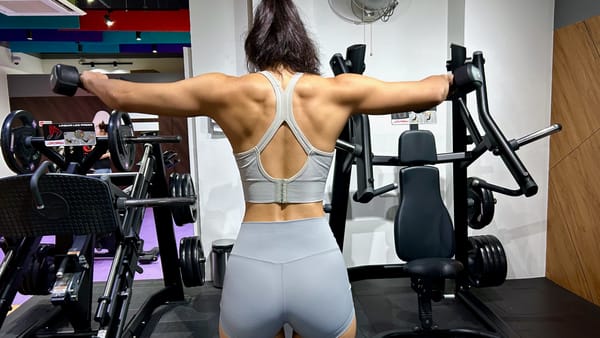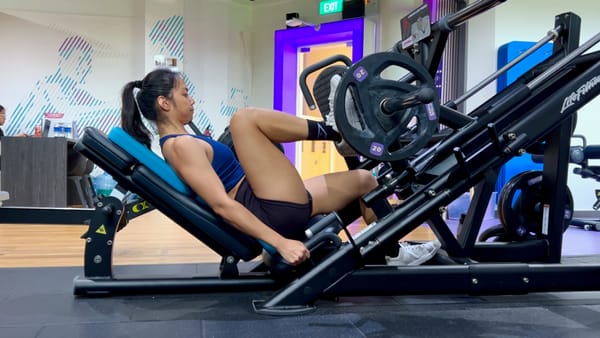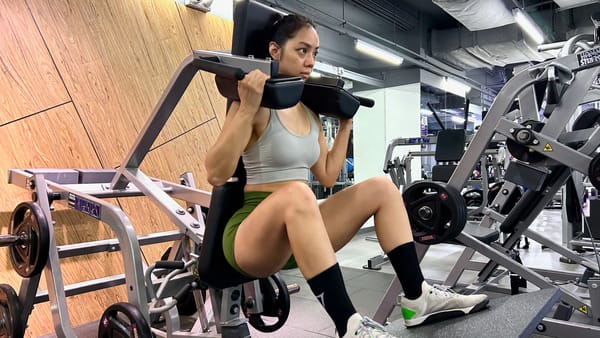20 Smith Machine Exercises to Try (5 Muscle Groups)
Think Smith machines are useless? Or dangerous? Think again. Here are 20 Smith machine exercises that are safe and great for hypertrophy.
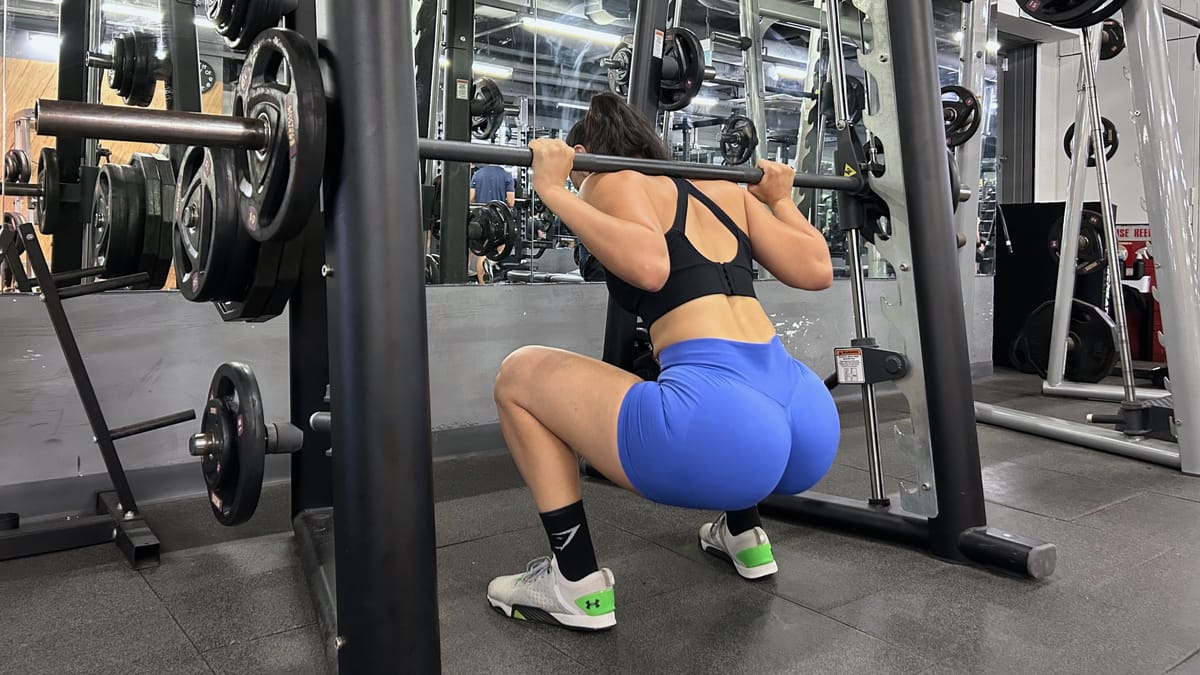
Thinking about trying Smith machine exercises but nervous about all that hate surrounding them? Well, you've been missing out.
Smith machines have been grossly misunderstood for a long time (more on that near the end).
👉 In practice, the Smith machine can be a safe, useful — and regularly available — piece of equipment in the gym.
Perfect if you always have to deal with a crowded gym.
Overview of Smith machine exercises
To get you started, here are 20 Smith machine exercises covering 5 different muscle groups.
(Psst: only practical, easy-to-progress exercises made it to this list. We didn’t just stuff it with every option we found.)
Here's an overview of all the exercises we're exploring to save you some scrolling time.
Smith machine leg exercises:
- Smith machine squat
- Smith machine hip thrust
- Smith machine split squat
- Smith machine Bulgarian split squat
- Smith machine reverse lunge
- Smith machine step-up
- Smith machine Romanian deadlift (RDL)
- Smith machine good morning
- Smith machine standing calf raise
- Smith machine sissy squat
Smith machine back exercises:
Smith machine shoulder exercises:
Smith machine chest exercises:
Smith machine arm exercises:
Smith machine leg exercises
Smith machine squat
This one’s always a favorite! It’s a great complement to the regular squat.
Demo of the Smith machine squat:
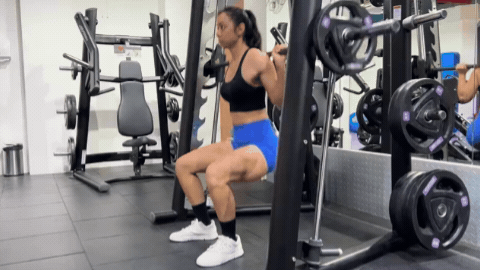
Feet position
Common mistake?
Positioning your feet directly under the bar like in a regular squat. This limits your range of motion (ROM) and throws your form off.
Instead, when doing the Smith machine squat, position your feet slightly in front of the bar.
How much exactly depends on your anatomy, mobility, and the machine.
Too far forward or backward isn’t going to work. So, take some time to find the sweet spot for yourself.
Position your feet in front of the bar:

Here’s how you can tell if your feet position is suitable:
- Feet too far forward: lower back rounds, feet sliding forward
- Feet too far back: heels lift off, limited ROM
- Feet position just right: lower back stays neutral, feet firmly planted, full ROM
In terms of how it feels, the Smith machine version sits somewhere between a regular squat and a hack squat.
Angled smith machine setup
If you have it in your gym, the angled Smith machine offers more variations than the vertical Smith machine.
Where to face on the angled Smith machine for squats:
@laurensimpsonofficial Quad vs Glute: Smith machine squats! Let me know if this was helpful. #fyp #gymtok #smithmachine #gymhack #squat #fitness #smithmachinesquats ♬ Big Boy (SZA) - Sped Up Remix - viral audios & nightcore sped up
By adjusting where you face on the angled Smith machine, you can emphasize different muscle groups.
- Facing inward (bar moves backward as you descend): more glutes (maximizes hip flexion)
- Facing outward (bar moves forward as you descend): more quads (maximizes knee flexion)
Smith machine B-stance squat
Want to emphasize one leg more? Or working on an imbalance?
Try the Smith machine B-stance squat:
@elvirafitness This literally destroyed my quads 🥵 #quadkiller #quadsfordays #quadmommy
♬ Strut - Kyle Walker
Smith machine hip thrust
The Smith machine hip thrust offers a much easier and faster setup than the regular barbell version.
Here’s how it’s done:
@madswagfit Replying to @lem How to do Hip Thrusts on the Smith Machine so you can grow your glutes 🍑🍑 (Wearing @AYBL dc ‘madison’ to save $$ 🫶🏻) I looove doing hip thrusts on the smith machine because you’re able to really focus on targeting your glutes 🍑 They’re also great for beginners or shy gym girls because you can stay in one place and don’t have to move around a bunch of heavy equipment ✨ Give these a try next time you go to the gym for leg day! #smithmachineworkouts #smithmachineglutes #gluteworkout #smithmachinehipthrusts #gluteworkout #smithmachineworkouts #glutegrowthworkout #fitnesstips
♬ original sound - Madison Hoover
No more dragging the barbell across the gym or worrying if someone would trip over you (perhaps after an insane leg day).
For setting up, follow the same fundamentals for hip thrusts. Only difference? You can’t roll the bar to adjust how far it is from you.
That’s why you need to get the distance between the bar and the bench just right.
Start with just outside shoulder width between bar and bench.
How to set up the Smith machine hip thrust:
@laurensimpsonofficial How to set up for smith machine hip thrusts 🍑 what other exercises do you need help with? #fyp #gymtok #hipthrustsetup #glutes #smithmachine #fitnesstutorial
♬ Hot (Remix) [feat. Gunna and Travis Scott] - Young Thug
Angled Smith machine setup
On the angled Smith machine, do your hip thrusts facing inward to the machine.
In most cases, that’s really your only option since there isn’t enough room to set it up facing outward.
Can’t get enough depth
Some Smith machines have safety stoppers that cannot be removed.
These will prevent you from going low enough and getting the full ROM on the hip thrust.
But all you need is a little tweak: elevating your feet with a step board or weight plates.
Elevate your feet to get more ROM on the hip thrust:
@laurensimpsonofficial Does your smith machine have these stoppers? Here’s a hack to get more range 🤓 let me know if this was helpful! #fyp #smithmachinehipthrust #hipthrust #gymhack #gymtok #glutetraining
♬ original sound - Lauren Simpson
Smith machine split squat
Want to go heavier on split squats? Try the Smith machine version.
Here’s a great demo of the front foot elevated Smith machine split squat (last slide):
Focus on keeping the weight on your front foot as much as possible.
Your back foot is simply there to maintain balance.
If you’re losing balance on the back foot, you could be relying on it a little too much. Slow down your reps and focus on pushing through the front foot.
Smith machine deficit split squat
Knee hitting the ground early? Increase the ROM by making it a deficit split squat.
Simply stand on weight plates, step boards, or floor mats for both feet.
Angled Smith machine setup
You can face either inward or outward for the Smith machine split squat.
Find what’s more comfortable for you.
If you’re just starting out, facing inward might feel more natural.
Facing inward (though this one's typically called the reverse lunge):
@michelle__barahona ✨ The Smith Machine Split Squat! Great for beginners in the gym, the smith machien helps with balance and stability. Using your weaker leg first, perform 12-15 reps on one side first, & then rest 30 seconds between legs. This one will hit the under glutes! ❤️🔥 #onlinetrainer #gym #gymtok #gymtip #workoutroutine #trainer
♬ escapism sped up by raye - ⭐️sped up audios⭐️
Facing outward (with elevation to increase ROM):
@drmikeisraetel Smith Machine Split Squats #legday #rpstrength #christmaseve
♬ All The Way Up (feat. Infared) - Fat Joe & Remy Ma & French Montana
Smith machine Bulgarian split squat
Bulgarian split squats don’t have to be done with dumbbells only.
The Smith machine version makes balancing easier so you can focus on your form or use more weight.
Great demo of the Bulgarian split squat (on vertical Smith machine):
@lanamakin bulgarian split squats on the smith machine are a killer! -@KEEPTHATPUMP #bulgariansplitsquat #smithmachine #legday #gymtok #gymgirl #2024 #legsworkout #workout
♬ Lifetime - Tobiahs
As with any unilateral leg exercise, focus on keeping the weight on the front foot.
Too difficult? Lower the elevation
Struggling to get it right with a bench?
Start with a lower elevation of your back foot.
A stepboard or some weight plates would be good enough. Progress from there as you improve your technique and gain more confidence.
Use a step board instead of a bench:
@angelique.stalker_fit The smith + a box = game changer. Wearing @DFYNE dc ANGELIQUE #gymtok #fittok #fyp #glutes #bulgariansplitsquats
♬ original sound - aeklaus
Angled Smith machine setup
Face inward for the Smith machine Bulgarian split squat.
This allows you to comfortably maintain a slight forward lean throughout the movement.
Bulgarian split squat on the angled Smith machine:
@bodiesbycass Smith Machine Bulgarian Split Squats for glutes!!! 🍑 #glutesworkout #gymtok #smithmachine #bulgariansplitsquat
♬ original sound - Bodies By Cassidy | Cassidy
How to set it up right:
@yassminn.rf Trust me keep these in your routine for a dumpy #progressnotperfection #entrenamiento #girlswholift #glutes #glutegainsforsummer #gluteworkout #bbl #howto
♬ NANANA COLA IAN ASHER EDIT Out Now On SoundCloud - Ian Asher
Smith machine reverse lunge
Think of the Smith machine reverse lunge as a dynamic version of the split squat.
Here’s how to do the Smith machine reverse lunge:
Instead of being stationary, you have to work with a back leg that’s constantly moving.
This makes it more challenging and technical than the split squat.
Note that you won't be able to use as much weight here as with the split squat. After all, you’re working your front leg through a larger ROM.
Limited in depth by your back knee? Consider elevating your front foot for greater ROM.
Elevate your front foot with a step board:
@michelle__barahona ✨ The Smith Machine Split Squat! Great for beginners in the gym, the smith machien helps with balance and stability. Using your weaker leg first, perform 12-15 reps on one side first, & then rest 30 seconds between legs. This one will hit the under glutes! ❤️🔥 #onlinetrainer #gym #gymtok #gymtip #workoutroutine #trainer
♬ escapism sped up by raye - ⭐️sped up audios⭐️
Angled Smith machine setup
Face inward for the Smith machine reverse lunge.
This aligns better with the backward movement of the lunge.
Smith machine step-up
If you’ve always found Bulgarian split squats painful and difficult, the Smith machine step-up is going to make you reconsider.
Here’s an awesome Smith machine step-up demo:
@deannaodfit A MUST for glute gainss #glutes #glutegrowth #glutegains #stepups #gymmotivation #gymtok #gymgirls #girlswholift #fyp #fypツ
♬ original sound - Ruthie21😘 - ꧁ Ruthie ꧂
It’s a wonderful unilateral movement that tests your balance, coordination, and strength all at once.
Compared to dumbbell step-ups, the Smith machine version lets you worry less about falling off and instead, focus more on your technique.
Pay attention to the eccentric part of the exercise.
Come down in a slow, controlled way — and never use your back leg as a brake.
As a guide, you should be controlling the movement enough for your toes to land very gently.
Here’s how to set up the Smith machine step up:
@_chloeear most requested tutorial is how do I set up step us! here is a quick video on how I set up step ups on a Smith machiene save this for you next glute day! want to progress this? check my page pinned video. personal training coaching links are in my bio want more training inspiration? head to My ig! _chloeear training programs and coaching link in bio! #onlinefitness #onlinept #onlinecoaching #onlinetrainer #onlinecoach #onlinegymcoach #fitnessjourney #fitnesscoach #stepups #stepup #smithmachinestepups #smithmachinestepup
♬ Murder - Bgnzinho
Interestingly, there’s an alternative setup.
You don’t see it done often, but it's a great way to get even more stability for the step-up.
Another way to set up the step-up (on a vertical Smith machine):
@kimfrench87_ You HAVE to try Step Ups on the Smith Machine like this 🍑🔥
♬ Only You X Playdate - ded4$$
It makes balancing easier since you can hold on to the machine with one hand, plus you’re loading the opposite side of your body.
Angled Smith machine setup
Face inward for the Smith machine step up.
This puts you in a slight forward lean, which would feel more natural while also better targeting your glutes.
Not for everyone
That said, there are 2 major drawbacks to the Smith machine step-up:
- You can’t do it if you’re too tall: the Smith machine won't’ be tall enough to accommodate the combined height of you and the platform
- You need a platform tall enough for you: anything too short will limit your ROM and reduce the effectiveness of the step-up
Got to watch the head on the step-up:
@kat.penelope Surely I’m not the only one? 😂😂 Wearing @AYBL as usual, use the link in my bio to shop and support me😎 AYBL slay every day xxx #smithmachine #smithmachinestepup #aybl #tallgirl #tallgirlgym #tallgymgirl #gymtok
♬ Ice Biden - schmoyoho
Smith machine Romanian deadlift (RDL)
While not quite as popular as the barbell or dumbbell versions, the Smith machine RDL is a true workhorse. You get to really focus on the eccentric here.
Doesn’t get any better than this:
@katiecousinsss she hits the sweet spot 🤝🏽 #fyp #gymmotivation #smithmachinerdls #fitnessmotivation #gymgirl #glutegrowth
♬ original sound - davi
Who doesn’t love a good juicy stretch on the RDL?
Angled Smith machine setup
To maximize your hip flexion, face inward during your RDL.
This shows the RDL setup perfectly (on an angled Smith machine):
This setup allows the bar to stick close to your legs at the bottom half of the movement, right where you’re trying to drive your hips as far back as you can.
It lets the bar and your hips move in the same direction.
When done facing outward, the bar moves away from your leg as you hinge — “pulling” you forward. This limits how far back your hips can go.
Smith machine B-stance RDL
B-stance lets you shift more of the load toward the front leg.
Just be sure to put most of your weight on the front foot, involving your back leg as little as you can.
Here’s a Smith machine B-stance RDL:
@hayleymadiganfitness Give B-Stance Pause RDL’s on the smith machine a go 💪🏼 #legday #legworkout #rdls #weighttraining #strengthtraining
♬ Paint The Town Red - Doja Cat
Smith machine one-leg RDL
Looking for a unilateral option?
Here’s a Smith machine one-leg RDL:
Smith machine good morning
You’re familiar with the RDL, but the good morning exercise? Probably not.
Is it a wonderful exercise for your glutes and hamstrings? Absolutely.
Here’s an excellent demo of the Smith machine good morning:
The good morning shares the same movement pattern as an RDL.
Only difference: the weight is loaded on your shoulders.
This position keeps the weight further away from your hips (compared to the RDL) as you hinge, making it more challenging. That’s why you have to use a lot less weight on the good morning.
Angled Smith machine setup
Just like with the RDL, face inward to maximize hip flexion.
This setup allows the bar to move in the same direction as your hip hinge.
Smith machine B-stance good morning
As always, you can focus on one leg a little more.
Let’s not forget the Smith machine B-stance good morning:
@kzfetters B-stance good mornings🔥 12-week glute building program is live in bio🔗✨
♬ The Fallen - Slowed - Caleb Bryant
Smith machine standing calf raise
Time to train the good ol’ calves. (We know you’ve been pretending that calves don’t exist.)
Solid demo of the Smith machine standing calf raise:
@camilawellness_club Exercise Smith Machine Standing Calf Raise!!! #leg #legday #legworkout #calf #calfworkout #wellness #fit #fitness #fitnessmotivation #gym #gymlife #gymmotivation #workout #fitnessgirl #bodybuilding #bodybuildingmotivation #fittips #fitnesstips #fittok #fitnesstiktok
♬ Strut - Kyle Walker
Aim to get a deep stretch in the calves at the bottom range of the Smith machine standing calf raise.
The benefit of using the Smith machine for this?
You can really focus on the stretch without worrying about the balance.
Yes, the balance is an especially big deal for calf raises since you’re only standing on the front portion of your feet. It’s an unstable position to begin with so any additional stability helps.
Angled Smith machine setup
You can face inward or outward for the standing calf raise. The movement is small enough for it to not have much difference.
Setting up calf raise (on an angled Smith machine):
@megmaefit The burn is real 🔥 #fitness #gym #workouts #calfraises #smithmachine #gymtok #fypシ #fy
♬ Trunk - Phonk Killer & Kingpin Skinny Pimp
Smith machine sissy squat
OK, this kick-ass quads exercise is tough. Really tough.
Don’t jump into it thinking it’s just any other squat because this is way more intense.
Can’t imagine?
Just look at this Smith machine sissy squat:
@joey_celentano Smith machine sissy squats 🤫 #fyp #quads
♬ som original - Koyubi
The sissy squat helps you target your quads in the lengthened position, more so than in a typical squat.
New to the movement? Start small and slow.
Focus on a slow eccentric, drive your knees forward, and feel the stretch in your quads.
Start with a bodyweight sissy squat (it’s hard enough):
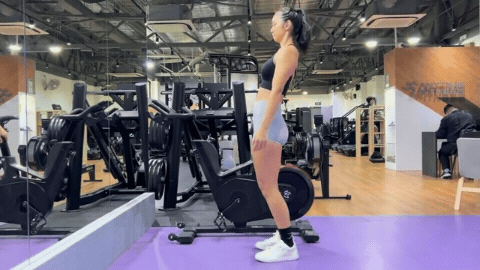
Angled Smith machine setup
Face outward for the Smith machine sissy squat.
This allows the bar to move forward, just like your body does, during the sissy squat.
Smith machine back exercises
Smith machine bent over row
Looking for a time-tested back exercise? The Smith machine bent over row is the one.
Here’s how to do the Smith machine bent over row:
@stutzmandanielle #smithmachinerow #trainwithdanielle
♬ Chill Vibes - Tollan Kim
Compared to the barbell bent over row, the Smith machine version lets you emphasize the stretch at the bottom even better.
You can do it with both the pronated or supinated grip.
The supinated version will involve your biceps more.
Angled Smith machine setup
Face outward for the Smith machine bent over row.
This aligns most closely with the bar path of the regular bent over row where the weight moves toward your core.
While you can do it facing inward, you’ll be shifting the emphasis from lats to your upper back (bar will move toward chest). This is typically not the focus here.
Smith machine one-arm row
Want to work on a weaker side? Give the Smith machine one-arm row a shot.
Here’s an excellent setup for the Smith machine one-arm row:
It might look complex, but it’s a pretty straightforward movement.
The key here is getting yourself into a stable position.
Position yourself sideways to the Smith machine. Adopt a staggered half-squat stance and anchor your elbow into your thigh.
Smith machine chest supported row
If you’re looking for more stability in your rows, there’s no better way than adding chest support.
Here’s how to do the Smith machine chest supported row:
@phil_agostino If your gym doesn't have a chest support T-bar row, try this... #backday #musclebuilding #gymtips
♬ snowfall - Øneheart & reidenshi
Chest support keeps you anchored throughout your reps, allowing you to work with much heavier weights and get a deep stretch at the bottom.
The chest-supported T-bar row was built for this. But what if you can’t find it in your gym?
Well, you've got to DIY … and that’s where the Smith machine chest supported row comes in.
Angled Smith machine setup
Just like the bent over row, face outward for the Smith machine chest supported row.
This is more aligned with the movement of a regular bent over row where the weight moves toward your core.
Compromise on the range
There’s a drawback to this DIY solution, of course.
Typically, your range is limited by the bench.
To be specific, you can’t contract fully at the top of the bent over row since the bench will prevent the bar from going any higher.
In practice, you could go a little heavier to compensate for this shortened ROM.
Smith machine rack pull
Not familiar with rack pulls? Don’t worry.
They’re simply partial deadlifts where you only perform the top half of the deadlift movement.
Here’s a demo of the Smith machine rack pull:
@tashatrains These were hard, 215 3x6 #deadlift #GymTok #girlswholift #rackpulldeadlift
♬ Here I Come - Lola Brooke
If you’re proficient with the deadlift, you’re all set!
Compared to the conventional deadlift, the rack pull has a shorter ROM, which means you can work with much heavier weights.
The weight increases further with the Smith machine rack pull since it’s a more stable setup.
Angled Smith machine setup
Face outward for the Smith machine rack pull. This keeps the bar closer to you at the top position.
Don’t hog weights unintentionally
Heads up for strong folks: be mindful of how many weight plates you’re taking up!
Take note of how busy the gym is — and whether you’re hogging what limited weights there are to go around.
Rack pulls (Smith machine or barbell) are notorious for this very reason. Don’t be that person.
Check out this insane Smith machine rack pull:
Smith machine shoulder exercises
Smith machine shoulder press
The Smith machine shoulder press is a mainstay for good reasons.
Here’s how it’s done:
@mettetjell Fra gårdagens upper 1🤍 med fokus på at kontrollere top og end range i denne øvelse🫶🏼 #fypシ #foryoupage #fyp #foryou #viral #dansktiktok #dansktræning #gymtok #gym #upperbody #smithmachine #shoulderworkout #fypシ゚viral #failure
♬ Long Way 2 Go - Cassie
With the Smith machine setup, you can use heavier weights than with the dumbbell shoulder press since there’s less balancing involved.
Here’s how to set up the Smith machine shoulder press:
@petermiljak Smith Machine Shoulder Press - The bench angle is going to be different for everyone, however you want to set it upright but comfortable on uour shoulders. Keep elbows slightly tucked and wirsts / elbows stacked through the movement. Think about driving biceps and elbows in towards your ears. Control the eccentric, work in your full active range. - #gymtiktok #gymtok #shoulderworkout #shoulders #shoulderpress #gymtips
♬ original sound - Peter Miljak
The best part of the Smith machine?
You don’t have to worry about getting the weights into position.
Yes … we’re talking about all that intense bracing, breathing, and focusing needed just to kick your dumbbells into place.
If you work out alone (or can’t get a spotter for heavier sets), the Smith machine could be a safer option for shoulder presses.
Angled Smith machine setup
Face outward for the Smith machine shoulder press. This bar path is closer to what you get with an overhead press.
Shoulder press on the angled Smith machine:
@faizzariffin Seated Smith Machine Shoulder Press 💯 #protips to max out your shoulder growth if you have been stuck on going heavier weights and put more tension on the shoulder. #shoulderworkout #workouttips #fitnessmotivation
♬ original sound - Faiz Ariffin - Faiz Ariffin
Seated vs standing Smith machine shoulder press
Shoulder presses (dumbbell or Smith machine) are often done seated for added stability.
This helps you better focus on targeting the shoulders rather than fighting to stay balanced in a standing position.
That said, it’s entirely fine to do it standing (especially if you can’t get your hands on a bench).
Here’s a standing Smith machine shoulder press:
@fitbae.n Work them shoulders 💪🏽🔥 #shoulderworkout #shoulder #smithmachine #smithmachineworkouts #workout #gym #gymreel #gymmotivation #kuwait
♬ original sound - Nour Alshedeid ♡ نور
Just note that some Smith machines could be too short for you to go through the full ROM of a standing shoulder press.
Smith machine one-arm shoulder press
Want to hit each shoulder separately? Here’s the Smith machine one-arm shoulder press.
How it’s done:
@zahrafit.cpt The Smith Machine single shoulder side press is an exercise that specifically targets the deltoid muscles in the shoulders. By using the guided motion of the Smith Machine, individuals can safely and effectively work on strengthening their shoulders without having to worry about balance or stabilization, which is often a concern with free weights. Moreover, the unilateral nature of this exercise allows each shoulder to work independently, helping to correct any muscle imbalances that may exist between the left and right sides of the body. This promotes balanced strength development and reduces the risk of overcompensation or injury. Ultimately, by enhancing shoulder strength and stability, the Smith Machine single shoulder side press contributes to improved functional strength, which translates to better performance in daily activities and sports that involve overhead movements, such as lifting objects or participating in activities like basketball or tennis. #Shoulders #ShoulderWorkout #ShouldersWorkout #WorkoutIdeas #GymTok
♬ Limitless - Kairo & Sha'Ki
This is a half-kneeling position where your free hand is anchored against your knee for stability.
Smith machine shrug
You can’t talk about training shoulders without mentioning the trusty Smith machine shrug.
Here’s how the Smith machine shrug is done:
@marzrodie TARGET MUSCLE: Upper Traps SYNERGIST (SUPPORTING MUSCLES): Mid Traps, Scapulae MECHANICS: Isolation FORCE: Pull EXECUTION - Keep your elbows flexed as you exhale while you bring your shoulders towards your ears. - Inhale while you lower the bar to your starting position. #dxbfit #marzrodie
♬ original sound - Zp
This one’s a favorite for targeting your traps. And the Smith machine makes it so much easier to go heavy on this exercise.
Angled Smith machine setup
You can face either inward or outward for the Smith machine shrug.
The ROM is tiny enough for it to not have much difference.
If you had to choose, face outward so the bar is closest to you at the top position — right where you’re contracting the traps as hard as you can.
Smith machine one-arm shrug
Working on a weaker side or running out of weights? Try the one-arm shrug.
Position yourself sideways to the Smith machine for a more natural movement.
Great demo of the Smith machine one-arm shrug:
@coult_g One Arm Smith Shrugs #fyp #foryoupage #fitness #exercise #weightlifting #bodybuilding #muscle #workout
♬ original sound - Coult Greenwell
Smith machine upright row
Ahh … the controversial upright row. Made even more controversial with the Smith machine.
But relax.
This exercise made it to the list because as far as we know, there’s no evidence suggesting the upright row increases risk of injury.
Here’s a wonderful tutorial on the Smith machine upright row:
@brentonrosssimmons 👍 or 👎 on these? I say 👍 for someone w/ healthy shoulders and done w/ proper form ✅ #weightlifting #workingout #bodybuilding
♬ original sound - Brenton Simmons
As with any exercise, just be sensible!
If it feels funny or uncomfortable, skip it. If it feels good, progress gradually.
The Smith machine upright row can be an excellent shoulder exercise with the right technique.
Angled Smith machine setup
Face outward for the Smith machine upright row.
This is more aligned with the bar path on the barbell upright row.
Smith machine chest exercises
Smith machine bench press
The Smith machine bench press is an all-time favorite for good reason.
A great tutorial on setting up the Smith machine bench press:
@trainwithdave_ Want to work on your chest but only limited to the smith machine in your apartment or hotel gym? Our personal trainer Anthony has you covered. In this video we teach you how to set up your smith machine to properly do a bench press. Follow us for more nutrition, fitness and gym tips! __ #chestworkout #chestday #benchpress #chesticles #workout #workoutroutine #exerciseprogram #exercisetips #fitness #fitnessmodel #fitnesstips #fitnesscoach
♬ original sound - trainwithdave_
It’s a great complement to the conventional barbell bench press.
The Smith machine allows you to train with heavier loads by adding stability to the movement. Plus, it’s the safer option if you don’t have a spotter.
Angled Smith machine setup
For the Smith machine bench press, face outward.
This better replicates the bench press bar path and should feel the most natural.
Here’s the bench press (on an angled Smith machine):
@petersonk6fit Smith machine exercises are great. Especially if you are new to the gym 🥰 #chestpress #benchpress #smithmachineworkouts #upperbodyworkout
♬ Her Way (Sped Up) - PARTYNEXTDOOR
Smith machine incline press
Done with the bench press? Now you must hit the Smith machine incline press. (Can’t miss out on training the chest in a variety of angles, right?)
Here’s how to set up the Smith machine incline press:
@petermiljak Smith Machine Incline Bench Press - Set is important for this, making sure thise upper pec fibers are in the line of force/arm path. Keep chest up and shoulders back/down. Control every rep, and eccentric. Work in the full range of motion. - #gymtiktok #gymtok #chestworkout #chestexercise #benchpress #gymtips
♬ original sound - Peter Miljak
The setup is pretty similar to the Smith machine bench press.
Angled Smith machine setup
Face outward for the Smith machine incline press — just like with the bench press.
This aligns better with the bar path you get on the incline barbell press.
How to set up the incline press (on an angled Smith machine):
@coach.frizzle Turn around & these are gonna feel SO different #smithmachinepress #smithmachineworkouts #chestpresstips #chestpressform #formtips #gymform #upperbodyexercises #greenscreenvideo
♬ original sound - EX7STENCE™
Smith machine arm exercises
Smith machine JM press (Kaz press)
Thinking about hitting your triceps? Look no further than the Smith machine JM press.
It’s a unique combination of 2 exercises: the close grip bench press and the skullcrusher.
Here’s how to set up the Smith machine JM press (Kaz press):
@laci_renee Save this Kaz Press tutorial for your next upper body day!! #kazpress #smithmachine #tutorial #beginnerworkout #exercisetutorials
♬ original sound - Laci Renee
If you’re wondering about the different names, the JM press refers to the barbell version, while the Kaz press refers to the Smith machine version. Both are named after the people who popularized them.
But not to worry, both exercises are based on the same movement patterns.
Angled Smith machine setup
Similar to the Smith machine bench press, face outward for this.
This bar path aligns most closely to that of the barbell version.
More comfortable
The Smith machine JM press might have an advantage over the barbell version.
It’s said to be more comfortable on the elbows since the Smith machine keeps the bar stable.
This allows you to use weights that can challenge your triceps without worrying about balance and being limited by elbow discomfort or pain.
Smith machine drag curl
Can the Smith machine hit your biceps? Absolutely, with the Smith machine drag curl.
Here’s how the Smith machine drag curl is done:
@fitbae.n You could also do these on a cable machine or a barbell 💪🏽🔥 love them! #bicepsworkout #dragcurls #biceps #girlsbiceps #tips #gymtips #workoutroutine #staple #favorite #gymfavorites #smithmachine #smithmachinebiceps #bicepcurlmachinetutorial
♬ original sound - Nour Alshedeid ♡ نور
The Smith machine drag curl is a fantastic bicep exercise. As the name goes, focus on keeping the bar close to your body and “dragging” it up.
If you’re familiar with incline dumbbell curls, the drag curl has a similar “arms leaning back” posture.
A big plus here is that you’re able to go pretty heavy on this for a bicep movement.
Angled Smith machine setup
Facing outward for the Smith machine drag curl would work best.
You want the bar to move toward you as you curl, so your elbows can travel backward naturally.
Caveat on angled Smith machines
A slight annoyance: there is no “standard” angled Smith machine.
The angle of the lean, and even the direction of the lean, can differ from brand to brand.
If you move between gyms quite a bit, adjust your setup based on what’s available.
Here’s the version we’re referring to when we say “angled”:
@madimilne_ Why does the movement feel so much better on smith machine tho 😩🤌🏼 @DFYNE #smithmachine #RDLs #glutes
♬ Gunna x Offset Fresh Out The Can - Unreleased 🔥
This Smith machine leans in the opposite direction (less common):
@deannaodfit Sooo underrated for leg days! @AYBL link in bio to shop and save at checkout! #smithmachine #smithmachineworkouts #splitsquats #legday #glutes #glutesworkout #gymtok #gymmotivation #gymgirls #aybl #ayblathlete #fyp #fypシ
♬ original sound - Ciàn Hill
If your angled Smith machine is orientated the “opposite” way, flip the suggestions we’ve made accordingly.
FAQs on Smith machine exercises
Are Smith machine exercises really dangerous?
Now, let’s get this out of the way — we know you’re still bothered.
Here are some common arguments against Smith machine exercises:
- Increases injury risk by forcing you into a fixed path
- Doesn’t train your stabilizer muscles
- Doesn’t teach you proper mechanics
Are these true?
As far as we know, there are no studies suggesting that the Smith machine is more likely to cause injuries or to give you poor form.
What’s with all the hate then? Well … here’s what we think.
Don’t be an idiot
Sure, smith machine exercises might look and feel easier than free weights. But don’t be fooled into thinking it’s really easier.
As tempting as it can be to try to squat a small cow because smith machines are “easy AF compared to free weights”, don’t do it.
Be as patient and meticulous toward Smith machine exercises as you’d be with free weights.
The same training fundamentals apply.
For every exercise, learn the proper setup and technique, progress in a safe and gradual manner, and don’t sacrifice form for weight.
Don’t rush the process simply because everything feels lighter and easier.
Besides, who said you had to commit to Smith machine exercises exclusively?
What about stabilizer muscles?
Yes, you don’t train your stabilizers as much on the Smith machine.
But what if that’s the point?
What if you’re trying to complement all that free weights training you’re doing? What if throwing in Smith machine exercises is helping you find better results?
Some wise words to keep in mind:
@sharellegrant A smith machine is easily the most hated piece of equipment in the gym🤷🏻♀️ ESPECIALLY for squatting-based movements! 👀 Do you like using a smith machine? Let me know! #smithmschine #gymtok #gymgirl #musclebuilding
♬ original sound - Sharelle Grant | Fitness Coach
Use Smith machine safety stoppers
Smith machines come with safety stoppers. They’re literally lifesaving since you’re more likely to go to failure on Smith machines.
Use them to stay safe! (And to make sure you don’t make it to a #gymfail).
Here’s why Smith machine stoppers are so important:
@dailyjlh I could have been squished. Use the safeties! #gym #gymtok #fitnesstips #gymbeginner #gymtips #safetybar #smithmachine #bulgariansplitsquat #splitsquat #gymfail #funnygym #relatablegymthings
♬ Careless Cbat - There I Ruined It
@justpaks.fit Me failing at the smith machine bench press😮💨 #smithmachinebenchpress #gymfail #funnyvideos
♬ Oh No - Kreepa
Are Smith machine exercises as good as free weights for hypertrophy?
This one’s good news.
For muscle growth, you can expect similar results whether you train with machines or free weights.
This means you can include both free weights and Smith machine exercises while still staying on track for hypertrophy.
In practice, customize your choice of exercises based on preferences, goals, and results.
Concerned about stabilizers? Include more free weights. Progressing better on Smith machines? Focus on them more. Want to hit PR on the back squat? Prioritize the back squat. You get the idea.
Now, go on and tackle the Smith machine with confidence.
Go experiment with all 20 Smith machine exercises; there'll almost certainly be at least a couple that'll become mainstays in your training routine. And remember:



